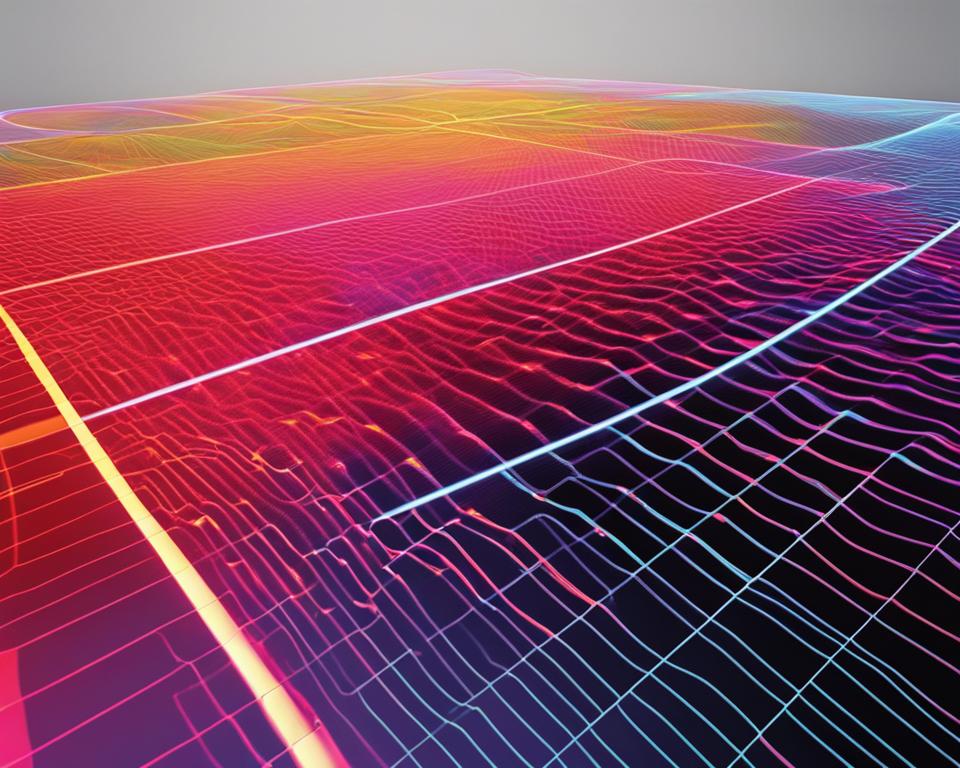When we think of light, we usually imagine what we can see. However, there is another type of light that is invisible to our eyes, but just as essential – infrared waves. These waves have a longer wavelength than visible light and are present all around us. Infrared waves have a wide range of uses, from medical imaging to remote sensing, and even in our daily lives.
In this article, we will explore the applications of infrared waves and how they serve society in a multitude of ways. We will delve into the role of infrared waves in medical imaging, remote sensing, security systems, and more. Come with us on a journey to discover the hidden potential of infrared waves.
Key Takeaways:
- Infrared waves are invisible to our eyes but have a wide range of uses.
- Applications of infrared waves include medical imaging, remote sensing, security systems, communication, heating, and astronomy.
- Understanding the importance of infrared waves is essential to appreciate their impact on our daily lives and the world around us.
Infrared Waves in Medical Imaging
Medical imaging has revolutionized the way doctors diagnose and treat diseases. Infrared waves play a significant role in medical imaging techniques such as infrared thermography and infrared spectroscopy. These technologies utilize infrared radiation to create images of the body, providing valuable insights into various health conditions.
Infrared thermography is used to capture thermal images of the body and measure temperature changes, which can be indicative of injury or disease. For example, it is used to detect breast cancer by detecting temperature differences in the breast tissue. Infrared spectroscopy, on the other hand, analyzes the organic and inorganic compounds in the body to identify the presence of disease.
These techniques are non-invasive and safe, making them an ideal alternative to traditional methods such as X-rays. They are also useful for monitoring the progress of treatment and detecting potential side effects. Infrared waves offer a powerful tool for modern medicine, allowing doctors to provide better care and improve patient outcomes.

Infrared Waves in Remote Sensing
Remote sensing is the process of collecting data about the Earth’s surface from a distance. In this field, infrared waves play a crucial role in detecting and analyzing different phenomena. Infrared sensors are capable of capturing infrared radiation emitted or reflected by various objects which helps scientists and researchers to study the planet and its environment in detail.
One of the most important uses of infrared waves in remote sensing is in weather forecasting. Infrared sensors are used to monitor temperature and humidity levels in the Earth’s atmosphere, which helps in accurately predicting weather patterns and severe storms. Infrared waves are also vital in monitoring vegetation health and detecting forest fires.
Moreover, infrared sensors are used in analyzing and detecting pollution levels in the atmosphere. In some cases, infrared remote sensing can detect oil spills and gas leaks, which is essential in preventing environmental disasters.

Overall, the applications of infrared waves in remote sensing are vast and crucial in understanding the Earth’s environment and its changes over time.
Infrared Waves in Security Systems
Security systems have become an essential part of our lives, protecting our loved ones and assets from unauthorized access. To enhance the effectiveness of security systems, infrared cameras and sensors are used widely.
Infrared cameras are efficient in low-light or complete darkness environments, making them an ideal tool for surveillance without interruptions. By detecting the infrared radiation emitted by living beings, infrared cameras can provide a clear image of the intruders, even in complete darkness. Motion detection using infrared sensors can also trigger alarms and alert the authorities.
In a commercial setting, infrared cameras have several benefits: they can monitor employee activity and detect any suspicious activities. Infrared sensors can detect temperature changes and identify fire outbreaks before they cause harm to human lives or property. This feature makes them a valuable addition to any security system.

In residential settings, infrared cameras and sensors provide homeowners with the peace of mind they need to sleep soundly at night. They can detect and capture footage of burglars in action, even if they are wearing masks. In combination with door and window sensors that use infrared radiation, alarm systems can alert homeowners of any suspicious activity.
In conclusion, infrared cameras and sensors play a crucial role in modern security systems. Whether in residential or commercial settings, these technologies make our lives more secure and peaceful.
Infrared Waves in Communication
Using infrared waves for communication has become increasingly common in the world today. Infrared communication technology enables wireless data transfer at short range. This concept is used in various devices such as infrared remote controls, wireless headphones, and short-range networking. Infrared communication technology is simple, affordable, and very reliable, making it an excellent option for many different applications.
The most common use of infrared communication technology is in infrared remote controls. These are widely used to operate various electronic devices such as televisions, air conditioners, sound systems, and even cameras. They work by sending signals from the remote control to the device through infrared waves. The device then performs the requested operation.
Wireless Headphones
Wireless headphones are also an excellent application of infrared communication technology. These devices use infrared light to transmit sound between the audio source and the headphones. They provide greater flexibility of movement, as there are no wires involved. They are also ideal in situations where noise should be kept to a minimum, such as in a library or laboratory.
Short-Range Networking
Infrared technology can also be used for short-range networking. This can be achieved using an infrared data association (IrDA) port, which is similar to a Bluetooth connection. This technology can be used in situations where you need to transfer data, but a wired connection is not feasible. For example, it could be used to transfer data between two laptops in the same room.
Overall, infrared communication technology has revolutionized the way we communicate with different devices. It is simple, affordable, and reliable, making it an excellent option for many applications.
Infrared Waves in Heating and Thermotherapy
Infrared waves have several applications in heating systems and thermotherapy due to their ability to transfer energy through radiation.
Space Heating

Infrared heaters are used for space heating by emitting heat waves that are absorbed by objects and people in a room, rather than heating the air. This method of heating is more efficient than traditional heating systems, as it can heat a room faster and can be directed towards specific areas where heat is needed.
Outdoor Heating
Infrared heaters can also be used for outdoor heating, such as in patios or commercial spaces. They are preferred over other heating systems as they do not heat the air, reducing energy wastage, and they can withstand windy environments.
Thermotherapy
Infrared waves have therapeutic uses in thermotherapy, where they are used to alleviate pain and inflammation in the body. Heat therapy using infrared waves is known to have a deeper penetration into the skin, helping to increase blood flow and relaxation of muscles.
In conclusion, infrared waves have several advantages over traditional heating systems, making them an ideal choice for various applications. They are energy-efficient, faster, and can direct heat towards specific areas. In addition, they have therapeutic applications in thermotherapy, providing pain relief and relaxation of muscles.
Infrared Waves in Astronomy
Stargazing has been a favorite pastime of people for centuries. However, it wasn’t until the invention of telescopes that we were able to witness the full beauty of the universe. Infrared telescopes have revolutionized the field of astronomy by enabling us to observe celestial objects that are invisible to the naked eye.
Infrared waves play a critical role in astronomy by allowing scientists to detect heat radiation emitted by celestial bodies, including stars, galaxies, and planets. Infrared telescopes are equipped with specialized sensors that can capture these faint signals and convert them into stunning visual images.
One of the biggest advantages of using infrared telescopes is that they can penetrate the vast clouds of gas and dust that obscure visible light, giving researchers a clearer view of the cosmos. This is particularly useful for studying the birth and evolution of stars and galaxies, which are shrouded in dense interstellar dust.
Another area where infrared telescopes shine is in the search for habitable exoplanets. By detecting the infrared radiation emitted by these planets, astronomers can determine their atmospheric composition and temperature, providing vital clues about their potential to support life.
In summary, the use of infrared waves in astronomy has opened up an entirely new window into the universe and transformed our understanding of the cosmos. As technology continues to advance, we can expect even more exciting discoveries to come.




